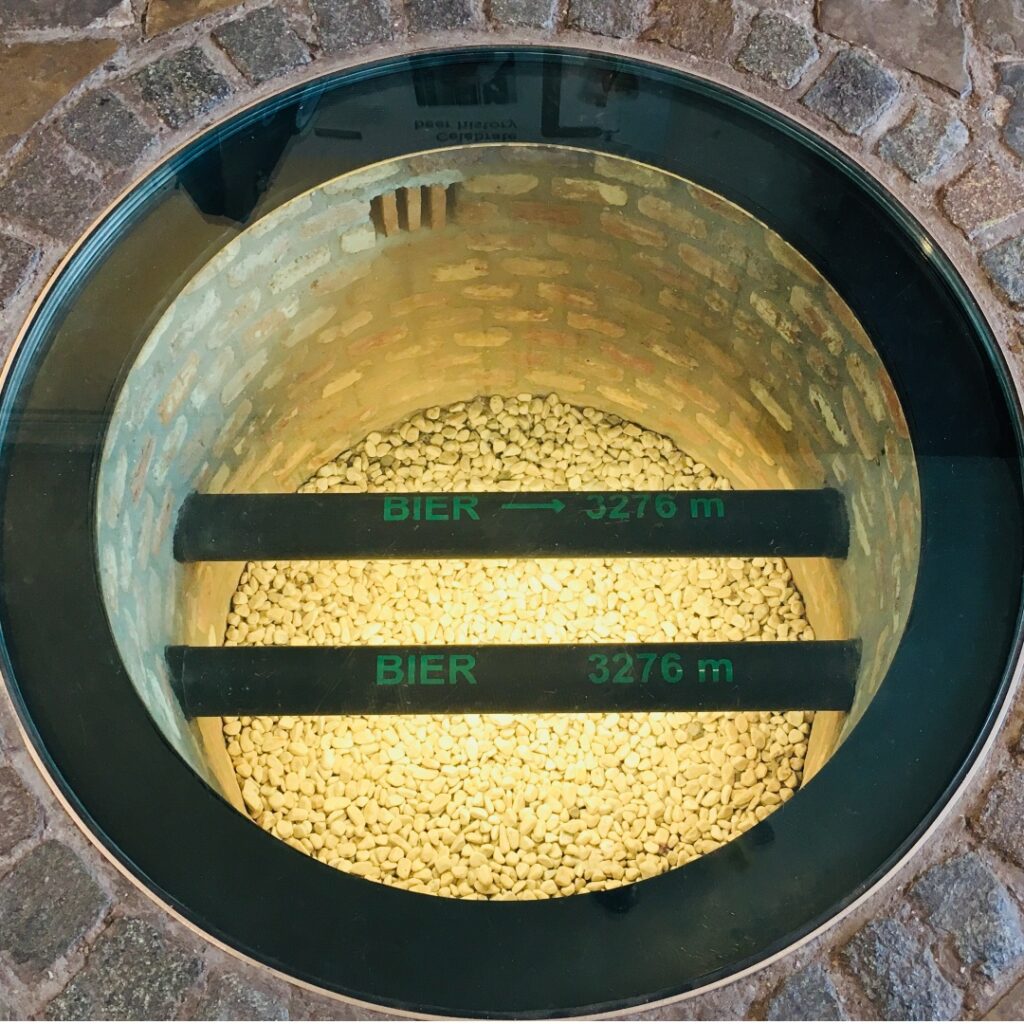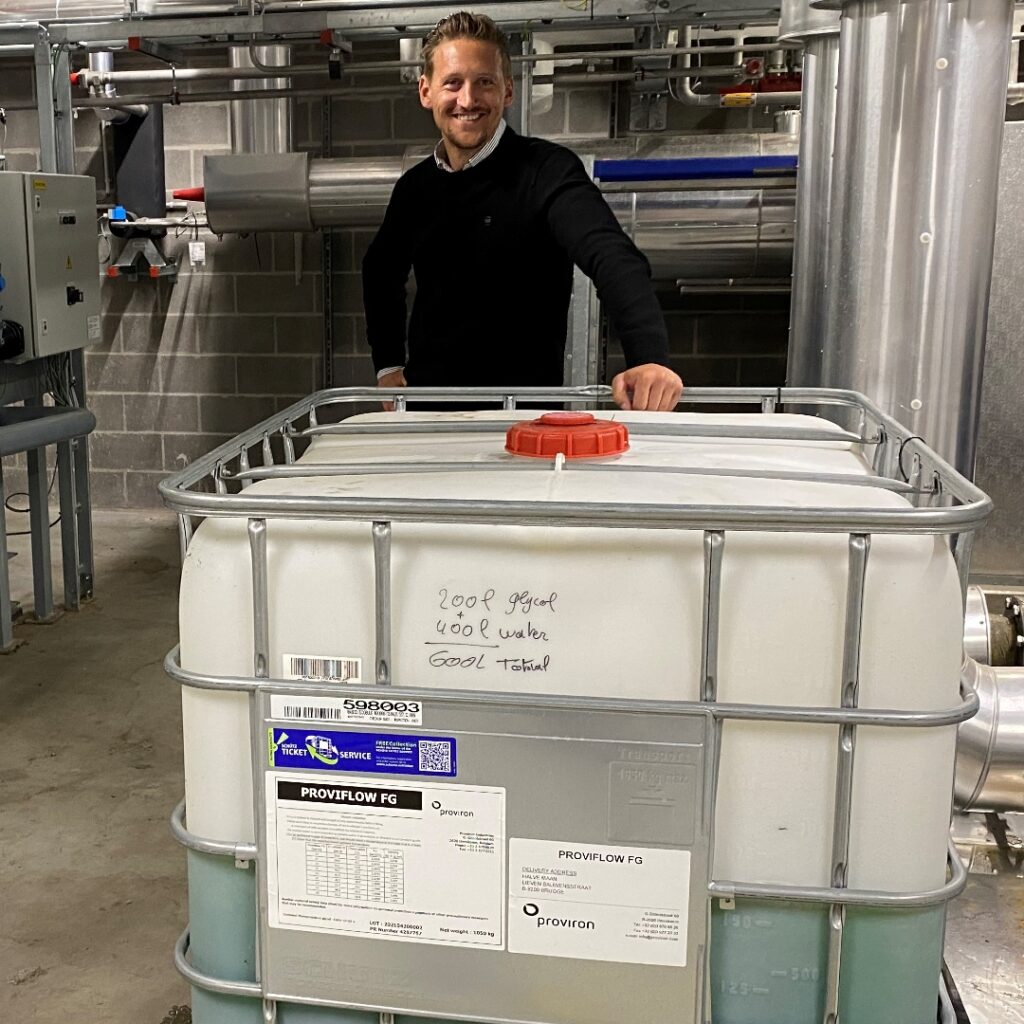
Brewery De Halve Maan uses Proviron's glycol
indirect cooling for bottling plant
In the previous edition of Cool & Comfort, we introduced you to the Proviron company and products. In this follow-up article, we look at a practical application: the cooling installation of the bottling plant of brewery De Halve Maan in Bruges.
brand-new bottling plant
De Halve Maan is a well-known city brewery of Bruges, with beers such as Straffe Hendrik, Brugse Zot or Brugs Witbier. Although the brewing itself is still done in the heart of Bruges, the bottling operations were moved outside the city a few years ago. To avoid constant truck traffic going back and forth between the two sites, they were connected to a 3.3 km long beer pipeline. That pipeline runs both ways: it also supplies the brewery with treated well water for the brewing process. In 2019, construction began on a brand-new bottling plant, which, after some delay due to Covid, was commissioned in May this year. For cooling, there is an indirect system with a Proviflow FG monopropylene glycol from Proviron.
versatile system
“The bottling plant has several cooling applications,” explains Brewmaster Frederik Verstringe of De Halve Maan. “First there is the lagering tank, where the beer is kept at -1°C for 21 days. This is crucial for flavor development. It’s followed by filtration at -1°C. This filtration system has an additional cooler to ensure the temperature of -1°C. Flash pasteurization is required before bottling, otherwise it cannot be sold. In this process, the beer is briefly raised to 78°C, and cooled again. When filling the bottles, the vacuum pump of the filler must be cooled. We use ice water here as well. The final stage in the production process is bottle refermentation. We have a special hot chamber that is kept at 22°C. Residual heat or ice water is used for this, depending on the temperature. Finally, there is the HVAC system of the building itself.”
“All of that is powered by an ammonia-based cooling system with a cooling capacity of 300 kW, which feeds a secondary delivery system with glycol. That system is maintained at -5°C, and then supplies the various applications. Some of these cool directly with glycol. For others, such as the HVAC system, there is an intermediate step with ice water. Depending on the application, there are separate circuits, with a mixing arrangement for temperature if needed. For the fermentation tanks, for example, there is a maximum difference of 10°C between the process temperature and temperature of the glycol, to prevent the yeast from receiving a thermal shock.
"In terms of leak detection, Proviflow conveniently comes with a color. We chose green here. The operator can see at a glance whether it could be a leak or if it is just condensation."
Frederik Verstringe, Brewmaster, De Halve Maan
safety by Proviflow FG
There are several reasons for choosing a glycol indirect cooling system. One is the complexity of the installation: given different flow rates and temperatures, an indirect system offers more flexibility.
“The main reason, however, has to do with safety,” explains Frederik Verstringe. “With direct cooling, there is always a chance that ammonia could enter the beer in the event of a leak. That would be a serious health risk, so it must absolutely be avoided. Of course, nobody wants glycol in their beer either, but if it did happen, the potential consequences are less significant, in part because we use food-grade glycol.”
“As far as leak detection is concerned, it is also convenient that the Proviron products can be given a color. Here we chose green. Several times during the process we have to deal with condensation. If you see a puddle or moisture on a component, it is not immediately clear whether you need to look for a leak or whether it is just condensation. With Proviflow, you can see that at a glance.”
sustainability as a priority
“The choice of ammonia was driven by a general commitment to sustainability,” says Frederik Verstringe. “Given the increasingly stringent F-gas regulations, we wanted a future-proof solution, and then you end up with natural coolants. We entrusted the design and implementation to Equans, which was fully on board with sustainability thinking.”
“The cooling load was initially calculated at 300 kW, and the installation was also designed to be able to expand to 600 kW, which made an ammonia installation economically interesting,” adds Joachim Houtekier of Equans. “With indirect cooling you do always have a loss of efficiency versus direct cooling, but because you can work very efficiently with ammonia, that was more than compensated.”
The brewery makes every effort to keep its carbon footprint as small as possible. Wastewater is collected and treated for reuse. Biogas is also extracted from that water treatment, and serves as fuel for steam production. The next phase will include PV panels on the roof, allowing the brewery to meet 65% of its needs itself. Large-scale heat recovery is also underway: the building’s heating is powered by residual heat.
corrosion protection
Corrosion must absolutely be avoided. This is all the more important in the food industry: it’s not just a question of ensuring that the plant functions properly, there must be no health risks from leaks or corrosion products. “The great enemy of glycol is oxygen: glycol will react with it so that acids form,” explains Gregory Jansseune of Proviron. “These in turn corrode the metal parts. Therefore, it is important that an installation is oxygen-tight, and that the glycol is diluted with degassed water. Furthermore, we recommend regular monitoring, with measurement of the pH. A measurement is a snapshot, it doesn’t mean much. If you have the results of multiple analyses, you can see a trend and then you know if it becomes necessary to intervene. At Proviron, we attach great importance to monitoring and follow-up. In fact, we are in the process of setting up a digital system to automate such tests.”
“Because a limited entry of oxygen is now inevitable, we also add inhibitors to the glycol. These will compensate for any decrease in pH due to interaction with oxygen, so that the liquid will not become more corrosive even if oxygen enters the installation. This avoids any potential problems. The Crescent can be assured of continued trouble-free operation.”
full article
by Alex Baumans
more info
www.halvemaan.be
www.equans.be




